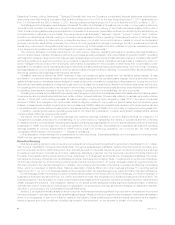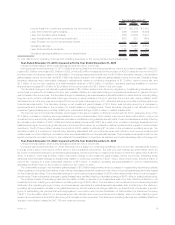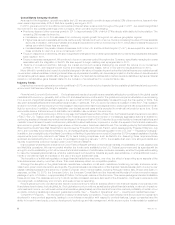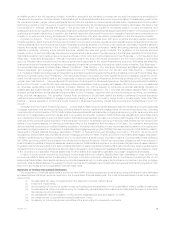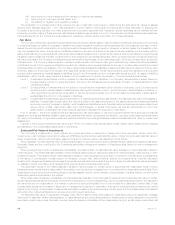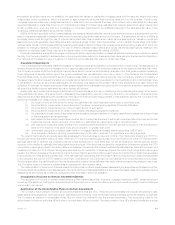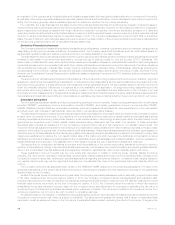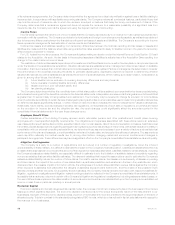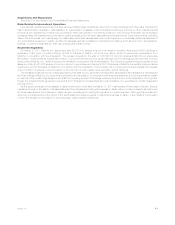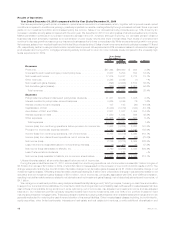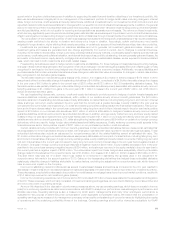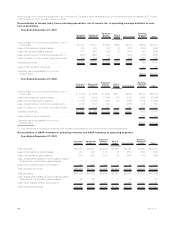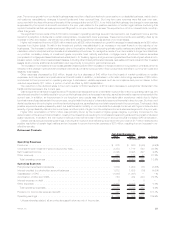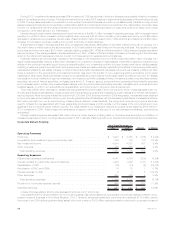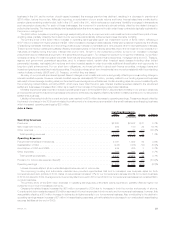MetLife 2010 Annual Report Download - page 19
Download and view the complete annual report
Please find page 19 of the 2010 MetLife annual report below. You can navigate through the pages in the report by either clicking on the pages listed below, or by using the keyword search tool below to find specific information within the annual report.of its reinsurance agreements, the Company determines whether the agreement provides indemnification against loss or liability relating to
insurance risk, in accordance with applicable accounting standards. The Company reviews all contractual features, particularly those that
may limit the amount of insurance risk to which the reinsurer is subject or features that delay the timely reimbursement of claims. If the
Company determines that a reinsurance agreement does not expose the reinsurer to a reasonable possibility of a significant loss from
insurance risk, the Company records the agreement using the deposit method of accounting.
Income Taxes
Income taxes represent the net amount of income taxes that the Company expects to pay to or receive from various taxing jurisdictions in
connection with its operations. The Company provides for federal, state and foreign income taxes currently payable, as well as those deferred
due to temporary differences between the financial reporting and tax bases of assets and liabilities. The Company’s accounting for income
taxes represents management’s best estimate of various events and transactions.
Deferred tax assets and liabilities resulting from temporary differences between the financial reporting and tax bases of assets and
liabilities are measured at the balance sheet date using enacted tax rates expected to apply to taxable income in the years the temporary
differences are expected to reverse.
For U.S. federal income tax purposes, the Company anticipates making an election under the Internal Revenue Code Section 338 as it
relates to the Acquisition. As such, the tax basis in the acquired assets and liabilities is adjusted as of the Acquisition Date resulting in a
change to the related deferred income taxes.
The realization of deferred tax assets depends upon the existence of sufficient taxable income within the carryback or carryforward periods
under the tax law in the applicable tax jurisdiction. Valuation allowances are established when management determines, based on available
information, that it is more likely than not that deferred income tax assets will not be realized. Factors in management’s determination consider
the performance of the business including the ability to generate capital gains. Significant judgment is required in determining whether
valuation allowances should be established, as well as the amount of such allowances. When making such determination, consideration is
given to, among other things, the following:
(i) future taxable income exclusive of reversing temporary differences and carryforwards;
(ii) future reversals of existing taxable temporary differences;
(iii) taxable income in prior carryback years; and
(iv) tax planning strategies.
The Company determines whether it is more likely than not that a tax position will be sustained upon examination by the appropriate taxing
authorities before any part of the benefit is recorded in the financial statements. A tax position is measured at the largest amount of benefit that
is greater than 50 percent likely of being realized upon settlement. The Company may be required to change its provision for income taxes
when the ultimate deductibility of certain items is challenged by taxing authorities or when estimates used in determining valuation allowances
on deferred tax assets significantly change, or when receipt of new information indicates the need for adjustment in valuation allowances.
Additionally, future events, such as changes in tax laws, tax regulations, or interpretations of such laws or regulations, could have an impact
on the provision for income tax and the effective tax rate. Any such changes could significantly affect the amounts reported in the
consolidated financial statements in the year these changes occur.
Employee Benefit Plans
Certain subsidiaries of the Holding Company sponsor and/or administer pension and other postretirement benefit plans covering
employees who meet specified eligibility requirements. The obligations and expenses associated with these plans require an extensive
use of assumptions such as the discount rate, expected rate of return on plan assets, rate of future compensation increases, healthcare cost
trend rates, as well as assumptions regarding participant demographics such as rate and age of retirements, withdrawal rates and mortality. In
consultation with our external consulting actuarial firms, we determine these assumptions based upon a variety of factors such as historical
performance of the plan and its assets, currently available market and industry data, and expected benefit payout streams. The assumptions
used may differ materially from actual results due to, among other factors, changing market and economic conditions and changes in
participant demographics. These differences may have a significant effect on the Company’s consolidated financial statements and liquidity.
Litigation Contingencies
The Company is a party to a number of legal actions and is involved in a number of regulatory investigations. Given the inherent
unpredictability of these matters, it is difficult to estimate the impact on the Company’s financial position. Liabilities are established when it is
probable that a loss has been incurred and the amount of the loss can be reasonably estimated. Liabilities related to certain lawsuits, including
the Company’s asbestos-related liability, are especially difficult to estimate due to the limitation of available data and uncertainty regarding
numerous variables that can affect liability estimates. The data and variables that impact the assumptions used to estimate the Company’s
asbestos-related liability include the number of future claims, the cost to resolve claims, the disease mix and severity of disease in pending
and future claims, the impact of the number of new claims filed in a particular jurisdiction and variations in the law in the jurisdictions in which
claims are filed, the possible impact of tort reform efforts, the willingness of courts to allow plaintiffs to pursue claims against the Company
when exposure to asbestos took place after the dangers of asbestos exposure were well known, and the impact of any possible future
adverse verdicts and their amounts. On a quarterly and annual basis, the Company reviews relevant information with respect to liabilities for
litigation, regulatory investigations and litigation-related contingencies to be reflected in the Company’s consolidated financial statements.It
ispossiblethatanadverseoutcomeincertainoftheCompany’slitigationand regulatory investigations, including asbestos-related cases, or
the use of different assumptions in the determination of amounts recorded could have a material effect upon the Company’s consolidated net
income or cash flows in particular quarterly or annual periods.
Economic Capital
Economic capital is an internally developed risk capital model, the purpose of which is to measure the risk in the business and to provide a
basis upon which capital is deployed. The economic capital model accounts for the unique and specific nature of the risks inherent in our
businesses. As a part of the economic capital process, a portion of net investment income is credited to the segments based on the level of
allocated equity. This is in contrast to the standardized regulatory RBC formula, which is not as refined in its risk calculations with respect to
the nuances of our businesses.
16 MetLife, Inc.


